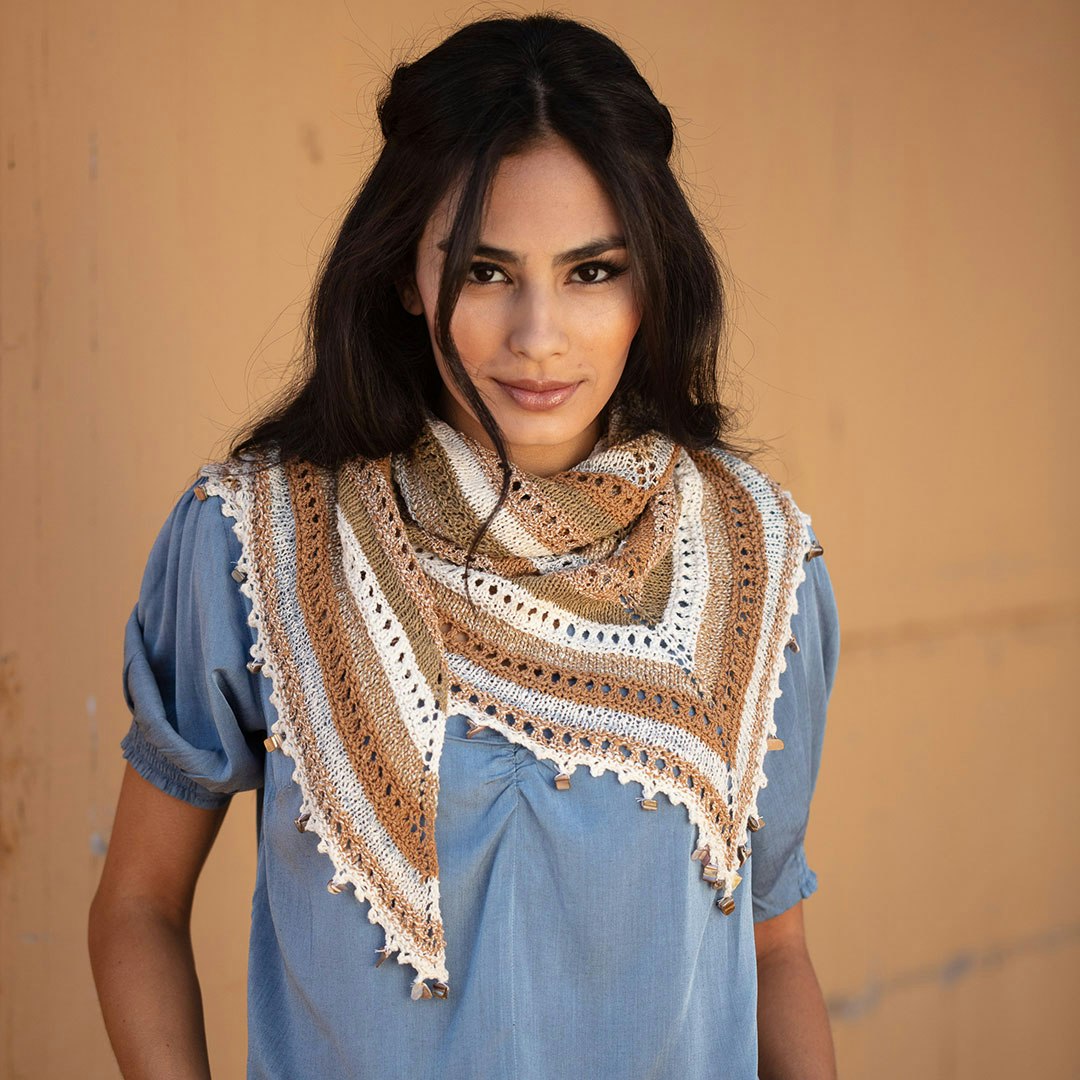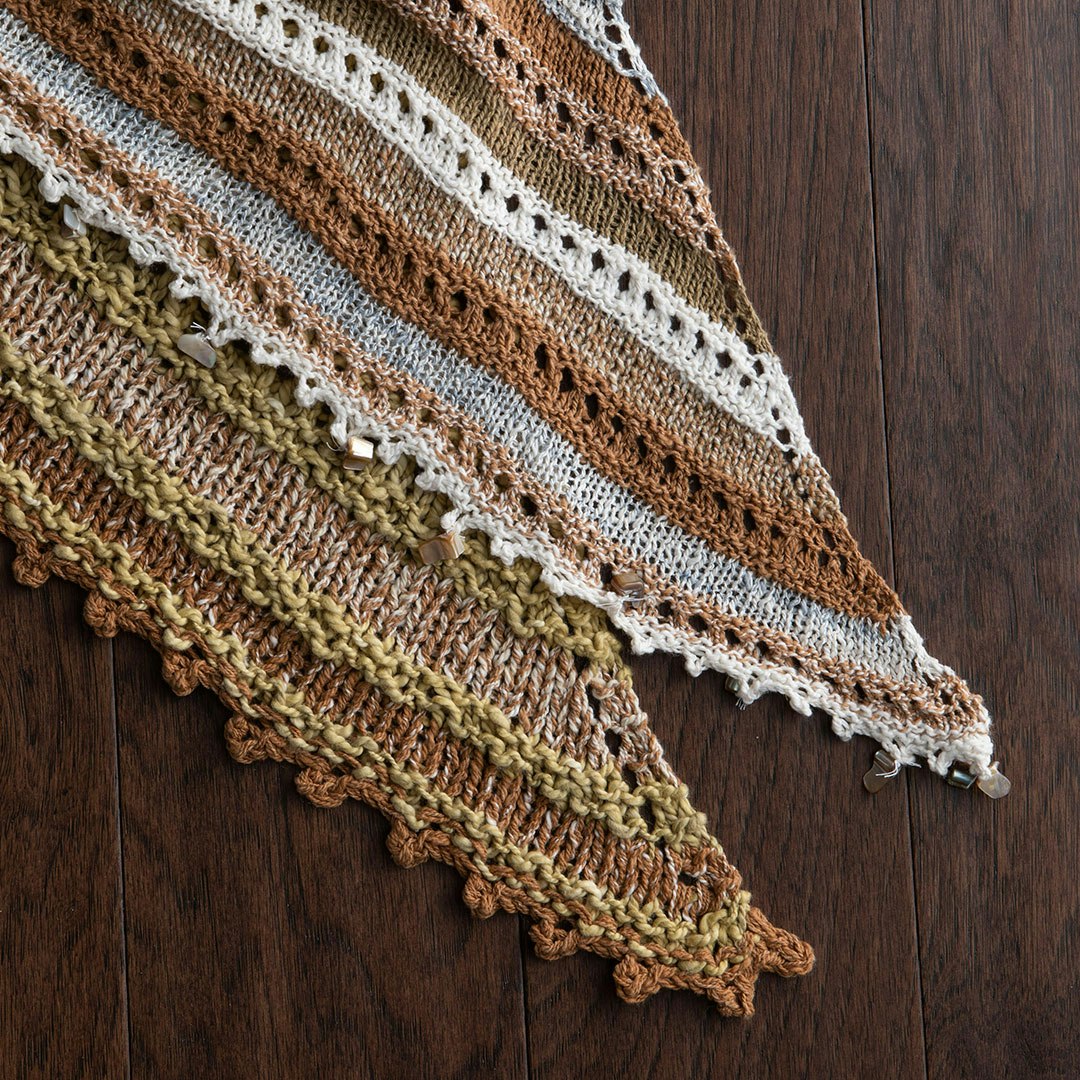Subscriber Exclusive
The Chameleon Shawl
This knitted shawl can be adjusted to suit different yarns and gauges, making it a perfect project to pair with your handspun cotton explorations. Log in to access this subscriber-exclusive shawl pattern made with handspun cotton.
This knitted shawl can be adjusted to suit different yarns and gauges, making it a perfect project to pair with your handspun cotton explorations. Log in to access this subscriber-exclusive shawl pattern made with handspun cotton. <a href="https://spinoffmagazine.com/the-chameleon-shawl/">Continue reading.</a>
https://spinoffmagazine.com/cdn-cgi/image/format=auto/https://www.datocms-assets.com/75073/1656689162-header-chameleon-shawl.jpg?auto=format&w=900
Handspun cotton can be used to create cloth with a cool, silky drape or a project that is as warm and luxurious as cashmere. However, spinners often shy away from using handspun cotton for knitting. They may say that it doesn’t have the loft and elasticity of wool or that it is hard to spin into a consistent yarn.
As with all fibers, these challenges can be managed with practice and skill. My best advice is to experiment by spinning many different types of cotton on many spindles and wheels. Creating the best cotton yarn for knitting is a creative spinning challenge. As you become comfortable with cotton, you’ll discover its strengths and weaknesses as well as your preferences.
The Chameleon Shawl can be adjusted to suit different yarns and gauges, making it a perfect project to pair with your handspun cotton explorations. The pattern is designed as a formula that allows you to use your senses and intuition to guide shawl construction. I call it a “chameleon” because it can adapt to whatever cotton yarn you spin. Add as many visual changes as you want by changing yarn colors or stitch-pattern intervals.
SUBSCRIBER EXCLUSIVE
Handspun cotton can be used to create cloth with a cool, silky drape or a project that is as warm and luxurious as cashmere. However, spinners often shy away from using handspun cotton for knitting. They may say that it doesn’t have the loft and elasticity of wool or that it is hard to spin into a consistent yarn.
As with all fibers, these challenges can be managed with practice and skill. My best advice is to experiment by spinning many different types of cotton on many spindles and wheels. Creating the best cotton yarn for knitting is a creative spinning challenge. As you become comfortable with cotton, you’ll discover its strengths and weaknesses as well as your preferences.
The Chameleon Shawl can be adjusted to suit different yarns and gauges, making it a perfect project to pair with your handspun cotton explorations. The pattern is designed as a formula that allows you to use your senses and intuition to guide shawl construction. I call it a “chameleon” because it can adapt to whatever cotton yarn you spin. Add as many visual changes as you want by changing yarn colors or stitch-pattern intervals.
[PAYWALL]

The laceweight version makes a stylish spring wrap. Photo by George Boe
Spinning Notes
For a laceweight shawl, spin about 3 ounces or 700 yards total; for fingering weight, spin about 4 ounces or 400 to 500 yards; and for a worsted weight shawl, spin about 10 ounces or 200 to 400 yards. This is not a hard-and-fast rule. You can knit this shawl large enough to wrap yourself into it like a cocoon or small enough to tie comfortably around your head or neck as a dainty kerchief. I like a nice versatile size of about 27 inches deep in the center with 6 feet across the top edge. You can spin and knit a chunky shawl or make it fine enough to slip through a wedding ring. You can use one color of fiber or mix and match as you please.
There are a number of ways to spin cotton, but I usually use a supported long draw whether I am using a wheel, supported spindle, or drop spindle. Long draw can be used to create lofty yarns, but the fiber needs to be well prepared so it drafts freely. Choose a fast ratio on your wheel or a spindle made for speed; you’ll need to accumulate twist quickly. Draw your fiber out, stretching your fiber-supply hand away from the spindle or wheel. Once you have an arm’s length of soft singles yarn, hold it for a few seconds as twist continues to accumulate and strengthens the yarn. Gently tug the fiber to help coax out any slubs.
To learn more about spinning cotton for knitting, read “Spinning Cotton for Knitting: Advice from a Cotton Lover” by Melvenea Hodges in Spin Off, Spring 2020.
—Editor
Materials
Fiber 3 (10) oz cotton.
Yarn 2-ply; 700 (400) yd; 22 (12) wpi; laceweight (worsted weight).
Needles Laceweight: Size 4 (3.5 mm): 32" circular (cir). Worsted weight: Size 11 (8 mm): 32" circular (cir). Adjust needle size if necessary to obtain the correct gauge.
Notions Markers (m); removable m; laceweight: size F/5 (3.75 mm) crochet hook; worsted weight: size L/11 (8 mm) crochet hook; tapestry needle; optional shell beads and sewing thread.
Gauge 21 (11) sts and 32 (19) rows = 4" in St st.
Finished Size 55 (63)" wide and 25 (26)" tall.
Visit www.spinoffmagazine.com/spin-off-abbreviations
for terms you don’t know.
Notes
- This triangular shawl is worked from the center neck down and outward to the points.
- Instructions are written for a laceweight shawl with changes for the worsted-weight version in parentheses.
- The shawl can be made larger or smaller by working more or fewer repeats of the garter eyelet and stockinette sections.
- A circular needle is used to accommodate the large number of stitches.
Download a PDF of The Chameleon Shawl ePattern.
Shawl
CO 5 sts.
Knit 2 rows.
Next row (RS) K1, [k1f&b, k1] 2 times—7 sts.
Next row (WS) Knit.
Set-up row (RS) K2, place marker (pm), yo, k1, yo, k1 (center st) and mark this st, yo, k1, yo, pm, k2—11 sts.
Next row Knit.
Garter eyelet section
Row 1 (RS) K2, sl m, yo, knit to center st, yo, k1 (center st), yo, knit to m, yo, sl m, k2—4 sts inc’d.
Row 2 (WS) Knit to center st, p1 (center st), knit to end.
Rows 3 and 4 Rep Rows 1 and 2.
Row 5 K2, sl m, yo, k1, *yo, k2tog; rep from * to center st, yo, k1 (center st), yo, ** ssk, yo; rep from ** to 1 st before m, k1, yo, sl m, k2—4 sts inc’d.
Row 6 K2, purl to last 2 sts, k2.
Rows 7–10 Rep Rows 1 and 2 two times.
Stockinette section
Row 1 (RS) K2, sl m, yo, knit to center st, yo, k1 (center st), yo, knit to m, yo, sl m, k2—4 sts inc’d.
Row 2 (WS) K2, purl to last 2 sts, k2.
Rows 3–6 Rep Rows 1 and 2 two times.
Rep garter eyelet and stockinette sections 9 (5) more times, or to desired length.
Laceweight only:
Work garter eyelet section.
Worsted weight only:
Work Rows 1 and 2 of garter eyelet section 2 times.
Work Rows 1 and 2 of stockinette section 2 times.
Work Rows 1 and 2 of garter eyelet section 2 times.

Add an optional picot bind-off. Photo by Matt Graves
Both versions: Crocheted picot bind-off
With crochet hook and RS facing, transfer first st to hook, yo and pull through st on hook, *transfer next st to hook, yo and pull through both sts on hook, ch 4, insert hook into first ch, yo and pull through ch and st on hook (picot made), [transfer next st to hook, yo and pull through both sts on hook (sl st made)] 2 times; rep from * to center st, work 2 picots into center st, ** work 2 sl sts then 1 picot; rep from ** to last st, transfer last st to hook, yo and pull through both sts on hook. Fasten off.
Finishing
Weave in ends.
Optional: Sew a bead to every 3rd picot, between the 2 picots at the point, and to 3 picots at each side of point.
Mist the shawl with water or starch solution from a spray bottle. Stretch and pat the shawl into shape. Allow to dry flat.
Melvenea Hodges is a fiber artist born and raised in Benton Harbor, Michigan. She is committed to practicing traditional textile techniques in honor and expression of her heritage as an American maker. She intermittently blogs about her latest creations and fiber adventures at www.traditionsincloth.com.
Originally published April 20, 2020.



